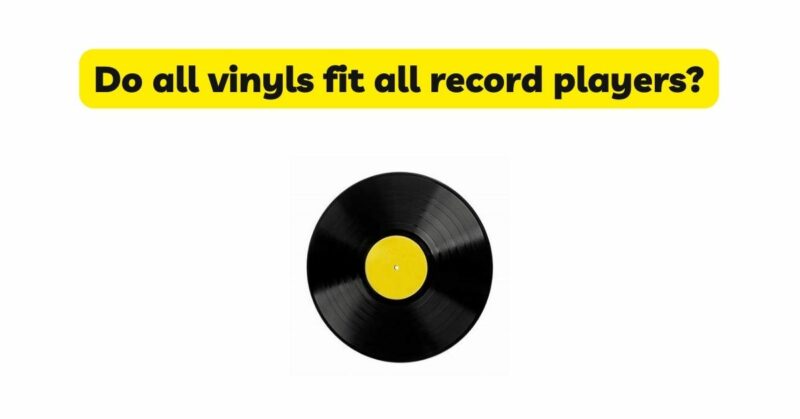Vinyl records have experienced a resurgence in popularity, offering a unique and tangible listening experience for music enthusiasts. As the demand for vinyl continues to grow, questions arise regarding the compatibility between vinyl records and record players (turntables). Do all vinyl records fit all record players? In this article, we will explore the factors that affect vinyl record compatibility with record players, including record sizes, speed settings, and record player specifications.
Vinyl Record Sizes:
Vinyl records come in different sizes, each serving a specific purpose or catering to different musical formats. The most common vinyl record sizes include:
- 12-inch LP (Long Play) Records: These are the standard size for full-length albums. They typically contain multiple tracks on each side and are played at a rotational speed of 33 1/3 revolutions per minute (RPM).
- 7-inch EP (Extended Play) Records: These smaller records are often referred to as singles. They typically feature one or two tracks per side and are played at a rotational speed of 45 RPM.
- 10-inch Records: Falling between the 12-inch LP and 7-inch EP sizes, 10-inch records were popular in the early days of vinyl records. They can be found in both 33 1/3 RPM and 45 RPM formats.
Compatibility with Record Players:
Record players, or turntables, are designed to accommodate different vinyl record sizes. Most modern turntables feature interchangeable platters or spindle adapters that allow for easy switching between record sizes. This compatibility enables users to play various vinyl record sizes on a single turntable.
The tonearm, which holds the cartridge and stylus, is adjustable in length to accommodate different record sizes. This adjustability ensures that the stylus tracks the grooves accurately for optimal playback quality. Additionally, turntables often have settings for adjusting tracking force and anti-skate to ensure proper stylus tracking for different record sizes.
While most turntables can handle standard record sizes, some older or specialty turntables may have fixed spindle positions, limiting their compatibility to specific record sizes. Therefore, it is essential to check the specifications of your turntable to ensure it can accommodate the record sizes you intend to play.
Speed Settings:
Vinyl records also require different rotational speeds for playback. The two most common speeds are 33 1/3 RPM and 45 RPM. The vast majority of records fall into one of these categories. However, it’s important to note that some specialty records, such as 78 RPM records, require a different speed setting and may not be compatible with all turntables. Make sure your turntable offers the appropriate speed settings for the records you plan to play.
Record Player Specifications:
In addition to record size and speed compatibility, other specifications of record players can impact the compatibility with certain vinyl records. Some factors to consider include:
- Cartridge Compatibility: The cartridge is the component that holds the stylus and tracks the grooves of the record. Different cartridges have different mounting styles and specifications. It’s important to ensure that your turntable’s tonearm is compatible with the cartridge you intend to use.
- Tracking Force Adjustment: Tracking force refers to the pressure exerted by the stylus on the record. Different cartridges have specific tracking force recommendations. Ensure that your turntable allows for tracking force adjustment within the range recommended by the cartridge manufacturer.
- Anti-Skate Control: Anti-skate control helps maintain proper stylus tracking by counteracting the inward pull of the tonearm towards the center of the record. It is important to have this control properly adjusted to avoid excessive wear or damage to the records.
- Tonearm Length: The length of the tonearm can vary between turntables. Some specialty records, suchas 10-inch or smaller records, may require a shorter tonearm to properly track the grooves. Ensure that your turntable’s tonearm length is appropriate for the record sizes you plan to play.
Conclusion:
In conclusion, not all vinyl records fit all record players. Vinyl record compatibility depends on several factors, including record size, rotational speed, and record player specifications. Most modern turntables offer compatibility with different vinyl record sizes through interchangeable platters or spindle adapters. The adjustable tonearm, tracking force, and anti-skate control allow for accurate tracking and playback across various record sizes.However, it’s important to check the specifications of your turntable to ensure compatibility with specific record sizes or specialty formats. Some older or specialty turntables may have fixed spindle positions or limitations that restrict compatibility to certain record sizes.Additionally, consider the rotational speed requirements of your vinyl records, as different records require specific speed settings such as 33 1/3 RPM or 45 RPM. Ensure that your turntable offers the appropriate speed settings for the records you plan to play.Lastly, factors like cartridge compatibility, tracking force adjustment, anti-skate control, and tonearm length should be considered to ensure optimal playback quality and minimize potential damage to the records.By understanding the compatibility between vinyl records and record players, you can select a suitable turntable that allows you to enjoy a diverse range of vinyl records and experience the unique magic of analog music playback.


